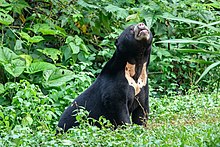
Back دب الشمس Arabic دب الشمس ARZ Melayaf Rupol (Helarctos malayanus) AVK Adi malay ayısı Azerbaijani مالایا آییسیهلارکتوس مالایانوس AZB Beruang madu BAN Малайска мечка Bulgarian Arzh Malaysia Breton Os malai Catalan Helarctos malayanus CEB
| Sun bear Temporal range: Middle Pleistocene–recent,[1]
| |
|---|---|

| |
| Sun bear in Kaeng Krachan National Park | |
| Scientific classification | |
| Domain: | Eukaryota |
| Kingdom: | Animalia |
| Phylum: | Chordata |
| Class: | Mammalia |
| Order: | Carnivora |
| Family: | Ursidae |
| Subfamily: | Ursinae |
| Genus: | Helarctos Horsfield, 1825 |
| Species: | H. malayanus
|
| Binomial name | |
| Helarctos malayanus (Raffles, 1821)
| |
| Subspecies[3] | |
| |

| |
| Distribution of the sun bear (2010)[2] (brown – extant, black – former, dark grey – presence uncertain) | |
| Synonyms[4] | |
|
List
| |
The sun bear (Helarctos malayanus) is a species in the family Ursidae (the only species in the genus Helarctos) occurring in the tropical forests of Southeast Asia. It is the smallest bear species, standing nearly 70 cm (28 in) at the shoulder and weighing 25–65 kg (55–143 lb). It is stockily built, with large paws, strongly curved claws, small, rounded ears and a short snout. The fur is generally short and jet black, but can vary from grey to red. The sun bear gets its name from its characteristic orange to cream-coloured chest patch. Its unique morphology—inward-turned front feet, flattened chest, powerful forelimbs with large claws—suggests adaptations for climbing.
The most arboreal (tree-living) of all bears, the sun bear is an excellent climber and sunbathes or sleeps in trees 2 to 7 m (7 to 23 ft) above the ground. It is mainly active during the day, though nocturnality might be more common in areas frequented by humans. Sun bears tend to remain solitary, but sometimes occur in twos (such as a mother and her cub). They do not seem to hibernate, possibly because food resources are available the whole year throughout the range. Being omnivores, sun bears' diet includes ants, bees, beetles, honey, termites, and plant material such as seeds and several kinds of fruits; vertebrates such as birds and deer are also eaten occasionally. They breed throughout the year; individuals become sexually mature at two to four years of age. Litters comprise one or two cubs that remain with their mother for around three years.
The range of the sun bear is bounded by northeastern India to the north then south to southeast through Bangladesh, Cambodia, Myanmar, Laos, Thailand, and Vietnam in mainland Asia to Brunei, Indonesia, and Malaysia to the south. These bears are threatened by heavy deforestation and illegal hunting for food and the wildlife trade; they are also harmed in conflicts with humans when they enter farmlands, plantations, and orchards. The global population is estimated to have declined by 35% since the 1990s. The IUCN has listed this species as vulnerable.
- ^ J. H. Schwartz, T. H. Vu, L. C. Nguyen, K. T. Le, and I. Tattersall. 1994. A diverse hominoid fauna from the late middle Pleistocene breccia cave of Tham Khuyen, Socialist Republic of Vietnam. Anthropological Papers of the American Museum of Natural History 73:1-11
- ^ a b c Scotson, L.; Fredriksson, G.; Augeri, D.; Cheah, C.; Ngoprasert, D. & Wai-Ming, W. (2018) [errata version of 2017 assessment]. "Helarctos malayanus". IUCN Red List of Threatened Species. 2017: e.T9760A123798233. Retrieved 16 January 2022.
- ^ Wozencraft, W. C. (2005). "Order Carnivora". In Wilson, D. E.; Reeder, D. M. (eds.). Mammal Species of the World: A Taxonomic and Geographic Reference (3rd ed.). Johns Hopkins University Press. p. 587. ISBN 978-0-8018-8221-0. OCLC 62265494.
- ^ Fitzgerald, C. S.; Krausman, P. R. (2002). "Helarctos malayanus". Mammalian Species. 696: 1–5. doi:10.1644/1545-1410(2002)696<0001:HM>2.0.CO;2. S2CID 198969265.
© MMXXIII Rich X Search. We shall prevail. All rights reserved. Rich X Search
